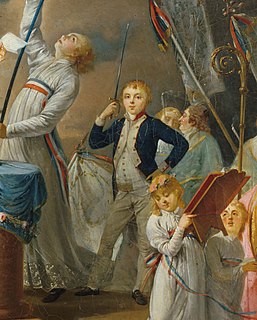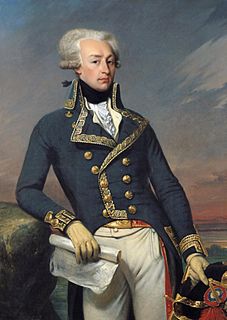
LaFayette is a town in Onondaga County, New York, United States. The population was 4,952 at the 2010 census. The town is named after the Marquis de Lafayette, a national hero of both France and the United States. LaFayette is in the southern part of Onondaga County, south of Syracuse.

Marie-Joseph Paul Yves Roch Gilbert du Motier, Marquis de La Fayette, known in the United States as Lafayette, was a French aristocrat and military officer who fought in the American Revolutionary War, commanding American troops in several battles, including the siege of Yorktown. After returning to France, he was a key figure in the French Revolution of 1789 and the July Revolution of 1830. He has been considered a national hero in both countries.

The siege of Yorktown, also known as the Battle of Yorktown, the surrender at Yorktown, or the German battle, ending on October 19, 1781, at Yorktown, Virginia, was a decisive victory by a combined force of the American Continental Army troops led by General George Washington and Gilbert du Motier, Marquis de Lafayette, and French Army troops led by Comte de Rochambeau over a British army commanded by British peer and Lieutenant General Charles Cornwallis. The culmination of the Yorktown campaign, the siege proved to be the last major land battle of the American Revolutionary War in the North American region, as the surrender by Cornwallis, and the capture of both him and his army, prompted the British government to negotiate an end to the conflict.

Sarah Vowell is an American author, journalist, essayist, social commentator and actress. She has written seven nonfiction books on American history and culture. She was a contributing editor for the radio program This American Life on Public Radio International from 1996 to 2008, where she produced numerous commentaries and documentaries and toured the country in many of the program's live shows. She was also the voice of Violet Parr in the 2004 animated film The Incredibles and its 2018 sequel.

Thomas Sully was an American portrait painter. Born in Great Britain, he lived most of his life in Philadelphia, Pennsylvania. He painted in the style of Thomas Lawrence. His subjects included national political leaders such as United States presidents Thomas Jefferson, John Quincy Adams, and Andrew Jackson, Revolutionary War hero General Marquis de Lafayette, and many leading musicians and composers. In addition to portraits of wealthy patrons, he painted landscapes and historical pieces such as the 1819 The Passage of the Delaware. His work was adapted for use on United States coinage.

James Armistead Lafayette was an enslaved African American who served the Continental Army during the American Revolutionary War under the Marquis de Lafayette. As a double agent, he was responsible for reporting the activities of Benedict Arnold – after he had defected to the British – and of Lord Cornwallis during the run-up to the Battle of Yorktown. He fed the British false information while disclosing very accurate and detailed accounts to the Americans.

Georges Washington Louis Gilbert de La Fayette was the son of Gilbert du Motier, Marquis de Lafayette, the French officer and hero of the American Revolution, and Adrienne de La Fayette. He was named in honor of George Washington, under whom his father served in the Revolutionary War.
The Lafayette Land Grant was a gift by the government of the United States of just over 23,000 acres (93 km2) of real estate in central Leon County, Florida, United States.

From July 1824 to September 1825, the Marquis de Lafayette, the last surviving French general of the American Revolutionary War, made a tour of the 24 states in the United States. He was received by the populace with a hero's welcome at many stops, and many honors and monuments were presented to commemorate and memorialize the visit.
William Hoogland (c.1794–1832) was an engraver in Boston, Massachusetts, and New York in the early 19th-century. "Career obscure; but was a designer and engraver of banknotes in New York in 1815." In Boston, contemporaries included Abel Bowen, Annin & Smith, and J.V. Throop. He taught engraving to Joseph Andrews.

Major General Marquis Gilbert de Lafayette is a statue in the southeast corner of Lafayette Square, in Washington, D.C., near the junction of Pennsylvania Avenue with Madison Place and close to the White House. The statue was erected in 1891 to honor Gilbert du Motier, Marquis de Lafayette and his contribution in the American Revolutionary War. The square, originally part of the President's Park, was named in honor of the Marquis in 1824. The statuary was made by Alexandre Falguière and Antonin Mercié, and the architect who designed the marble pedestal was Paul Pujol.

The Enosinian Society is a debate and literary society founded in 1822 during the first semester of the Columbian College that is currently known as The George Washington University Debate & Literary Society.
André-Nicolas Levasseur was a 19th-century French writer and diplomat known in the United States for accompanying the Marquis de La Fayette during his last trip to the Americas and in the Caribbean and Mexico for his involvement in French imperialism.

The Lafayette dollar was a silver coin issued as part of the United States' participation in the Paris World's Fair of 1900. Depicting Gilbert du Motier, Marquis de Lafayette with George Washington, and designed by Chief Engraver Charles E. Barber, it was the only U.S. silver dollar commemorative prior to 1983, and the first U.S. coin to depict American citizens.

Gilbert du Motier, Marquis de Lafayette (1757–1834), a French aristocrat and Revolutionary War hero, was widely commemorated in the U.S. and elsewhere. Below is a list of the many homages and/or tributes named in his honor:

The Lafayette Welcoming Parade of 1824 was a parade held in New York City on August 16, 1824, to welcome the arrival of the Marquis de Lafayette on the occasion of his visit to the United States for a sixteen-month tour. It has been described as the first triumphal parade in New York history.

The Lafayette Welcoming Parade of 1824 was a parade held in Philadelphia in September 1824 to welcome the arrival of the Marquis de Lafayette on the occasion of his visit to the United States for a sixteen-month tour.
Parkhurst Whitney was an American soldier, businessman, and early settler of Niagara Falls, New York who owned the prominent Cataract House.

Hero of Two Worlds: The Marquis de Lafayette in the Age of Revolution is a 2021 biography of the Marquis de Lafayette, including his clashes with the successive governments of France until his death in 1834. Lafayette is a hero of the American Revolution. After his return to France, Lafayette became a central figure during the French Revolution, was the main author of the 1789 Declaration of the Rights of Man and of the Citizen, and was active in the July Revolution of 1830. This book was written by Mike Duncan, a historian and podcaster. It was published in August 2021 by Public Affairs Press.
















